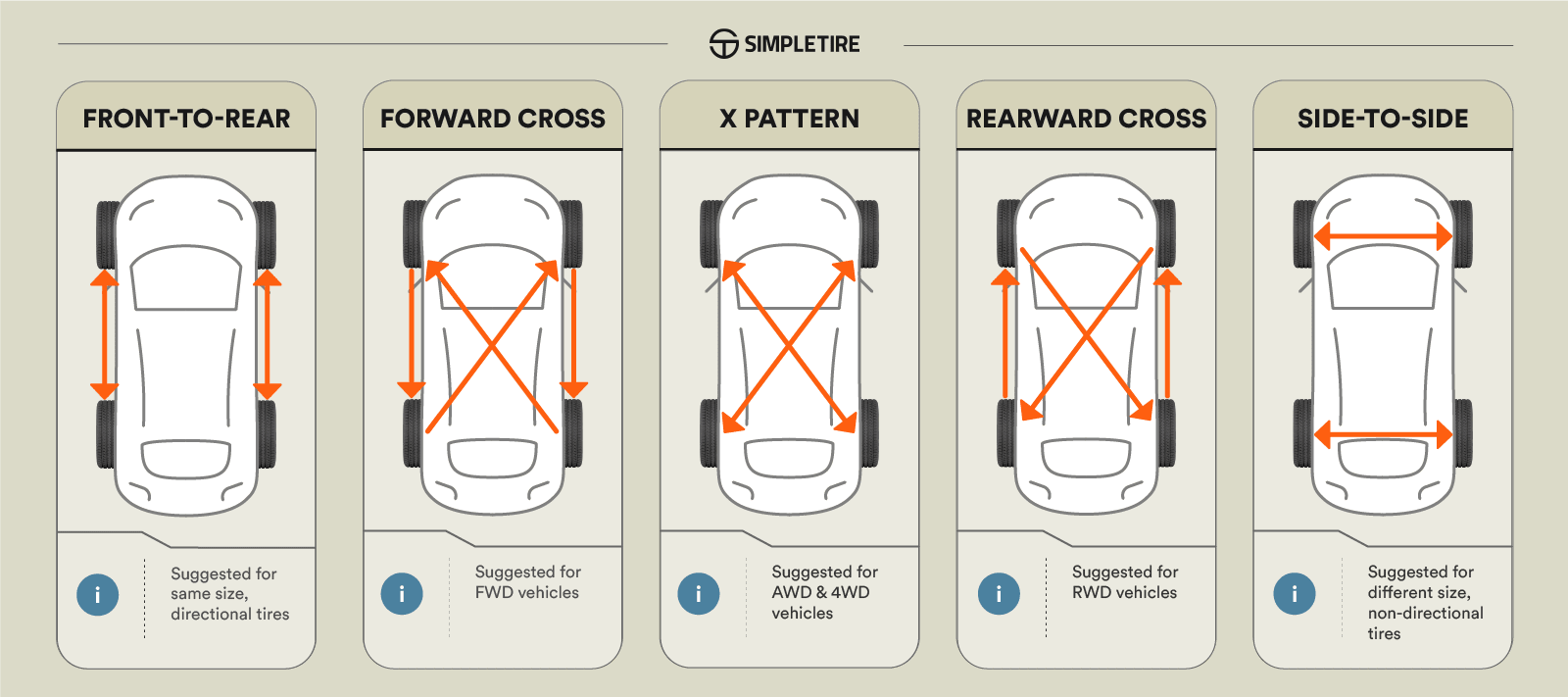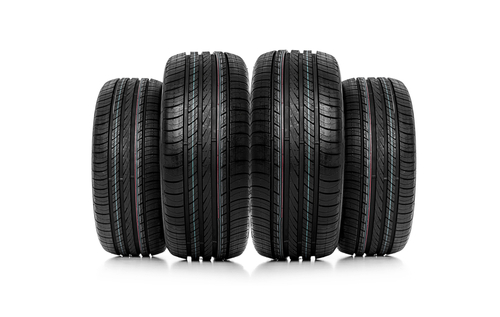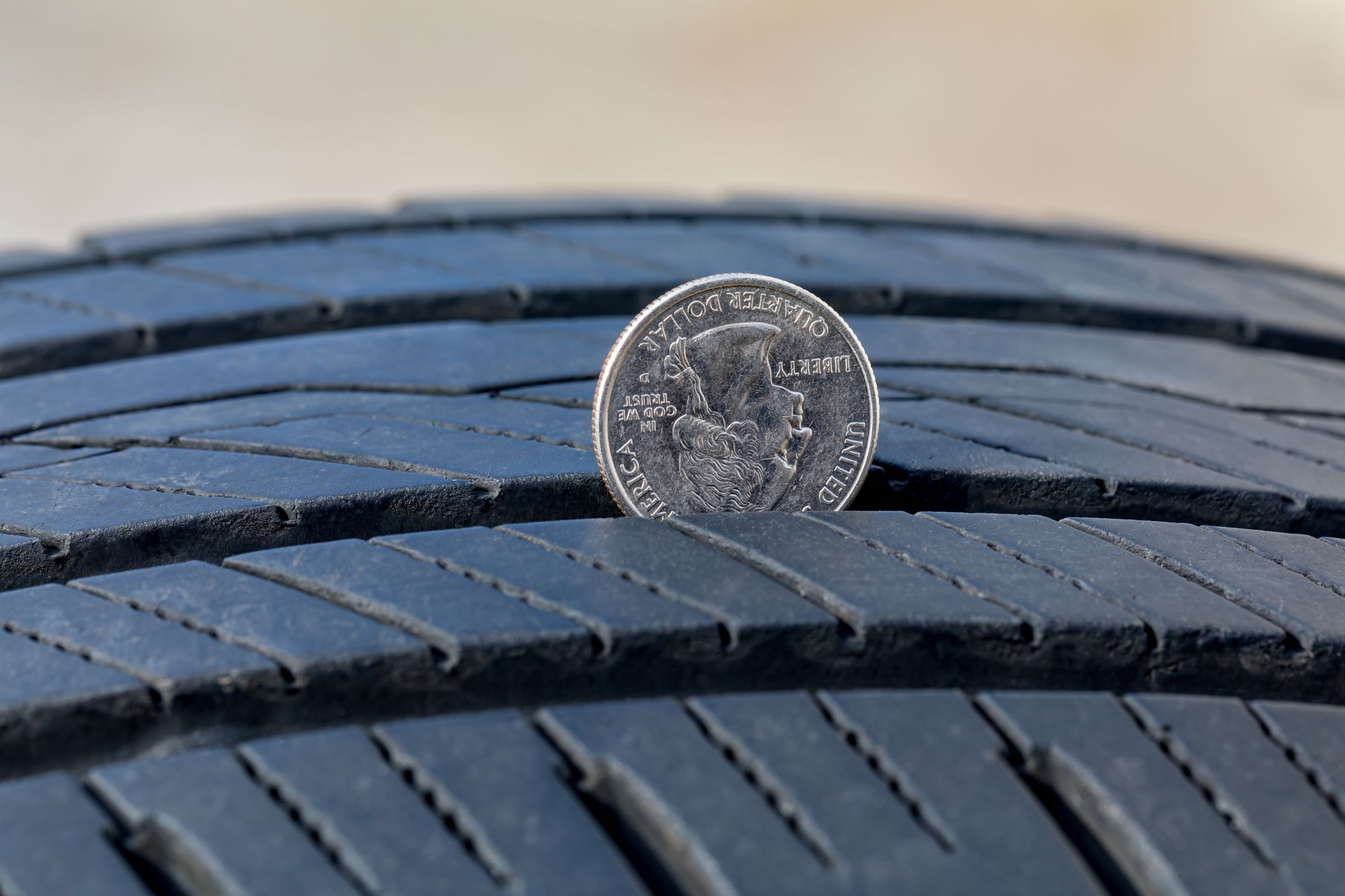Tire maintenance & safety

What if we told you rotating your tires was a simple job you can do to save hundreds, if not thousands of dollars over the lifetime of your vehicle. That’s right. It effectively extends the life of your tires.
We’re here to tell you everything you need to know about rotating tires. The more you know, the happier you will be to bust out the tools and get the job done.
What is tire rotation?
Tire rotation is the task of changing the position of the tires on your vehicle—it’s not simply rotating the tires by spinning them on the axle. For example, you might have heard about someone swapping the rear tires with the fronts in a crisscross pattern.
That’s a basic tire rotation pattern. You want to rotate your tires because the tires are subject to different stresses based on their location. By moving them around from time to time, you prevent those stresses from causing any significant wear issues.
What are tire rotation patterns?
Tire rotation allows drivers to get the most out of their tires, moving the tire’s position as part of regular vehicle maintenance. Simply crisscrossing the tires from back to front will work in some cases, but it isn’t always the best practice.
Different tire types have different rotation patterns. Directional tires can be rotated front-to-back, while some asymmetrical and symmetrical tires call for an X-shaped rotation pattern. You’ll need to refer to your manufacturer’s specs for the rotation instructions for your set of tires.
If you’re working with a front-wheel drive (FWD) vehicle, you want to do an FWD rotation. An FWD rotation with similar tire sizes on all four corners requires you to move the front tires to the rear tire position on the same side. Then, you move the rear tires to the front but on opposite sides.
A rear-wheel drive (RWD) tire rotation with similar tires on all four sides is the exact opposite. You move the rear tires to the front on the same side but move the front to the opposite rear tire position, like for Mustangs, Corvettes, or Chargers.
What if you don’t have the same size tires on all four corners, though?

If they’re directional but the same size-like most winter, high-performance or ultra-high performance tires-you simply swap the front tires with the rear tires on the same side.
If they are different sizes but non-directional-like those found on muscle cars, sports cars, and some SUVs-you switch the front tires from one side to the other and the same for the rear without swapping front or rear tires.
If you have directional tires of different sizes, you still need to rotate the tires by swapping them from opposing sides of the vehicle. However, they will need to be dismounted and remounted to ensure the tires spin in the correct direction. This is the only tire rotation situation that will call for specialty equipment.
Why is tire rotation important?
Weight is not evenly distributed across vehicles. The front will weigh more due to the engine in most cars, and electric vehicles feature even more weight due to their larger batteries. The difference in weight concentration results in irregular and nonuniform wear patterns. The inconsistencies can destroy your tires throughout several thousand miles, sending you to a tire shop prematurely.
By rotating your tires, you effectively correct these wear issues. This practice helps you get the most out of a set of tires, saving you money in the long run. Also, it ensures consistent performance from your tires which improves efficiency, traction, and safety.
How frequently should tires be rotated?
The old rule of thumb was to rotate your tires during every oil change. So what’s changed? Intervals between oil changes are far longer than they used to be. Back in the day, you changed your oil every 3,000 miles. Today’s vehicles can go as long as 10,000 miles between oil changes.
The best practice is to rotate your tires every 5,000-8,000 miles, meaning you might not be able to knock out both processes at the same time with modern vehicles.
You won’t hurt anything by rotating more frequently, which is why most people used to do it during oil changes, so you can combine oil changes with tire rotations if you’re driving an older vehicle.
How much does it cost on average to rotate tires?
How much you pay can depend. Some tire combinations call for unique routines that require additional steps. If you're working with a relatively basic setup, you'll likely pay about $10 per tire, totaling a $40 bill regardless of the vehicle's drive.
If you have a jack, jack stands, and are comfortable doing the work yourself, that's $40 you can keep in your wallet. So long as the tires don't need to be dismounted, you can easily do the work yourself in just a few minutes without ever having to set up an appointment.
If the tires do need to be dismounted, you will need professional help. While you're there, you will have the tires rebalanced as well because they are changing sides. The bill will probably come out to around $20-$30 per tire, so rotations are about $80-$120 in this case. That's just the name of the game with performance parts.
What happens if I never rotate my tires?
Tires will wear unevenly and it’s essential that their positions on the vehicle be changed regularly to even out that wear. Neglecting to rotate them will cause irregular and rapid wear. At the very least, this will shorten the life of your tires, and you will need to replace them sooner than you would if you had been rotating them.
It’s not out of the realm of possibility for irregular wear patterns to become dangerous either. For example, you might wind up chewing through a concentrated portion of the tire, which can lead to a leak or blowout.
What if you’ve neglected tire rotations until now? Is it too late? As long as the tires aren’t bald or showing chords, it’s never too late to start rotating your tires. You might not get as much life out of them as you would by rotating them from the beginning, but it will still extend tire life.
What else should I do?
Rotating your tires can be combined with a few other basic routines. However, since tire wear is the primary issue we’re trying to deal with here, you might as well take the time to check tread depth during tire rotations.
It’s wise to make sure you have ample tread and even wear across the tire. You can check tread with a penny, but a tread depth gauge is the best tool. If you can find any signs of irregular wear, it is a good indication that the vehicle has mechanical issues that need to be addressed.

It’s also good practice to inspect and adjust tire pressure at this time. As a rule of thumb, you should be checking tire pressure at least once a month. That’s the minimum amount, though. Keeping tire pressure in check also promotes even tire wear, and doing it more frequently will only heed better results.
Tire rotations aren’t rocket science, and you shouldn’t be intimidated by them. If you still don’t know how to rotate tires or are uncomfortable doing it, there’s no shame in asking for help.
Our customer service center is here to help you through all of your tire needs. If you aren’t sure of your tires’ condition or are considering a new set, we’re happy to help.
Ready to find the perfect tires?
Search By